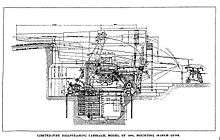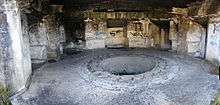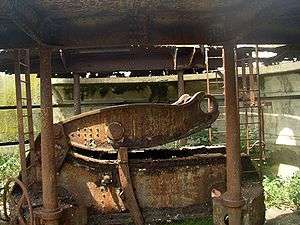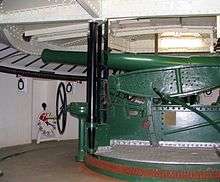Disappearing gun
_Gun_on_Moncrieff_disappearing_mount%2C_at_Scaur_Hill_Fort%2C_Bermuda.jpg)







A disappearing gun, a gun mounted on a disappearing carriage, is an obsolete type of artillery which enabled a gun to hide from direct fire and observation. The overwhelming majority of carriage designs enabled the gun to rotate backwards and down behind a parapet, or into a pit protected by a wall after it was fired; a small number were simply barbette mounts on a retractable platform. Either way, retraction lowered the gun from view and direct fire by the enemy while it was being reloaded. It also made reloading easier, since it lowered the breech to a level just above the loading platform, and shells could be rolled right up to the open breech for loading and ramming.
Some disappearing carriages were complicated mechanisms, protection from aircraft observation and attack was difficult, and almost all restricted the elevation of the gun. With a few exceptions, construction of new disappearing gun installations ceased by 1918. The last new disappearing gun installation was a solo 16-inch gun M1919 at Fort Michie on Great Gull Island, New York, completed in 1923. In the U.S., due to lack of funding for sufficient replacements, the disappearing gun remained the most numerous type of coast defense weapon until replaced by improved weapons in World War II.[1][2]
Although some early designs were intended as field siege guns, over time the design became associated with fixed fortifications, most of which were coastal artillery. A late exception was the use in mountain fortifications in Switzerland, where six 120mm guns on rail-mounted Saint Chamond disappearing carriages remained at Fort de Dailly until replaced in 1940.
The disappearing gun was usually moved down behind the parapet or into its protective housing by the force of its own recoil, which (on many models) lifted a counterweight. Before firing, the crew tripped a catch on the counterweight, causing it to fall and move the gun back up "into battery" (firing position).
Some disappearing guns also used compressed air,[3] while a few were built to be raised by steam.[4]
History
Captain (later Colonel Sir) Alexander Moncrieff,[5] improved on existing designs for a gun carriage capable of rising over a parapet before being reloaded from behind cover. His design, based on his observations in the Crimean War was the first widely adopted. The first experimental carriages of this type were wheeled.[6] His key innovation was a practical counterweight system that raised the gun as well as controlled the recoil. Moncrieff promoted his system as an inexpensive and quickly constructed alternative to a more traditional gun emplacement.[7]
The usefulness of such a system had been noted earlier, and experimental designs with raisable platforms or eccentric wheels, with built-in counterweights, were built or proposed. Some used paired guns, in which one cannon acted as the other's counterweight. An unsuccessful attempt at a disappearing carriage was King's Depression Carriage, designed by Rufus King, Jr. of the United States Army in the late 1860s. This used a counterweight to allow a 15-inch (381 mm) Rodman gun to be moved up and down a swiveling ramp, so the weapon could be reloaded, elevated, and traversed behind cover. It was not adopted. Part of a test installation at Fort Foote, Maryland remains.[8] King's design was better suited for breech-loaders; had the US not had a plethora of new muzzle-loaders just after the Civil War it may have seen wider use.
Buffington and Crozier further refined the concept in the late 1880s by allowing the counterweight fulcrum to slide, giving the gun a more elliptical recoil path. The Buffington–Crozier Disappearing Carriage (1893) represented the zenith of disappearing gun carriages,[9] and guns of up to 16-inch size were eventually mounted on such carriages. Disappearing guns were highly popular for a while in the British Empire, the United States and other countries. In the United States, they were the primary armament of the Endicott- and Taft-era fortifications, constructed 1898-1917. Simpler carriages with a limited disappearing function were initially provided for smaller weapons, the balanced pillar for the 5-inch gun M1897 and the Driggs-Seabury masking parapet for the manufacturer's 3-inch gun M1898. However, these could only be retracted at a limited traverse angle, thus could not be used in action, and were disabled during World War I in the "up" position, with new installations receiving pedestal mounts. Both carriage types and their associated guns were removed from service in the 1920s.[10]
Several mobile disappearing mounts appeared in France and Germany circa 1893. These included both road-mobile and rail-mobile designs. In France, Schneider produced a road-mobile design and St. Chamond a rail-mobile design, both for 120 mm (4.7 inch) weapons. The 0.6 meter rail affût-truck system of was used for 120mm and 155mm guns in WWI. Six 120 mm Modèle 1882 guns on St. Chamond mounts were deployed at Fort de Dailly in Switzerland from 1894 to 1939.[11][12] Krupp produced a rail-mobile 120 mm disappearing gun in 1900.[13]
Though effective against ships, the guns were vulnerable to aerial observation attack. After World War I coastal guns were usually casemated for protection or covered with camouflage for concealment.[14] By 1912, disappearing guns were declared obsolete in the British Army, with only a few other countries, particularly the United States, still producing them up to World War I[3] and retaining them in service until replaced by casemated batteries in World War II.[2][9]
The only major campaign in which US disappearing guns played a part was the Japanese invasion of the Philippines, which began shortly after the attack on Pearl Harbor on 7 December 1941 and ended with the surrender of US forces on 6 May 1942. The disappearing guns were the least useful of the coast defense assets, as they were positioned to defend against warships entering Manila Bay and Subic Bay and in most cases could not engage Japanese forces due to limited traverse. Despite attempts at camouflage, their emplacements were vulnerable to air and high-angle artillery attack.
Advantages
The disappearing carriage had several principal advantages:
- It afforded the gun crew protection from direct fire by raising the gun over the parapet (or wall in front of the gun) only when it was to be fired, otherwise leaving it at a lower level, where it was also able to be loaded easily.
- With its guns in a retracted position (down behind the parapet), the battery was much harder to spot from the sea, making it a much harder target for attacking ships. Flat trajectory fire tended simply to fly over the battery, without damaging it.
- Interposing of a moving fulcrum between the gun and its platform lessened the strain on the latter and allowed it to be of lighter construction while limiting recoil travel.
- Simple, well protected earthen and masonry gun pits were much more economical to construct than the previous practice of constructing the standing heavy walls and fortified casemates of a more traditional gun emplacement.
- The entire battery could be hidden from view in place when not in use, unlike a traditional fort, enabling ambuscade fire.
Disadvantages
The disappearing gun had several drawbacks as well:
- Some British carriage designs restricted maximum elevation to under 20 degrees and thus lacked the necessary range to match newer naval guns entering service during the early part of the 20th century.[9] (Buffington-Crozier carriages, at their final development, could manage 30 degrees on a 16-inch gun.[15]) The additional elevation gained by mounting the same gun on a later non-disappearing carriage increased their range.[16]
- The time taken for the gun to swing up and down and be reloaded slowed the rate of fire of some designs. Surviving records indicate a rate of fire of 1 round per 1 to 2 minutes for a British 8-inch (20 cm) gun, significantly slower than less complicated guns.[3] (By contrast, the Buffington-Crozier 16-inch mount could manage 1 round per minute; the barbette mount was only 20 percent faster, and was slower at some elevations.)
- The improvement in the speed of warships demanded an increased rate of firing. The disappearing gun was at a disadvantage compared with a gun that stayed in position as one could not aim or reposition a disappearing gun while it was in the lowered position. The gunner still had to climb atop the weapon via an elevated platform to sight and lay the weapon after it was returned to firing position,[9] or receive fire control information (range and bearing) transmitted from a remote location.
- Their relative size and complexity also made them expensive compared with non-disappearing mounts,[3] In 1918, the 12" DC gun cost $102,000, the barbette mounted gun $92,000.[17] This was more than made up, for some designs, by the reduced cost of protection. From the above reference, the cost of a 16" DC emplacement was $605,000, while a turreted guns proportional cost was $2,050,000.
Other applications
Gun lift battery
One very uncommon and even more complex type of disappearing gun was Battery Potter at Fort Hancock, Sandy Hook, New Jersey. This and a number of 12-inch barbette emplacements were constructed due to the inability of the early versions of the Buffington-Crozier carriage to accommodate a 12-inch gun. Built in 1892, the battery covered the approaches to New York harbor. Instead of using recoil from the gun to lower the weapon, two 12-inch barbette carriages were placed on individual hydraulic elevators that would raise the 110-ton carriage and gun 14 feet to enable it fire over a parapet wall. After firing, the gun was lowered for reloading using hydraulic ramrods and a shell hoist. While the operation of the battery was slow, taking 3 minutes per shot, its design allowed a 360° field of fire.[18]
Battery Potter required much machinery to operate the gun lifts, including boilers, steam pressure pumps and two accumulators. Due to the inability to generate steam quickly, Battery Potter's boilers were run nonstop during its 14-year life, at significant cost. After the proving of the Buffington-Crozier carriage for 12-inch guns, the United States Army abandoned plans to build several additional gun lift batteries.
Naval artillery
The concept was also attempted for conversion to a naval use. HMS Temeraire was completed in 1877 with two disappearing guns (11-inch muzzle-loading rifles (279 mm)) sinking down into barbette structures (basically circular metal protective walls over which the gun fired when elevated). This was to combine the ability of the early pivot guns to swivel with the protection of more classical fixed naval guns.[19] A similar design was later used in Russia for the first ship of the Ekaterina II-class battleships. It has been suggested that both the harsh saltwater environment and the constant swaying and rolling of a ship at sea caused problems for the complex mechanism.[9]
If the mechanism seemed too temperamental for the open sea, it was not true for rivers and harbors. Armstrong and Mitchell's 1868 HMS Staunch, a gunboat described as a "floating gun carriage", used a single 9inch Armstrong cannon on a lowering platform, and next to no armor. It was a resounding commercial success; there were 21 direct copies,[20] and another six near-sisters.[21] The simplified mounts were intended as much to lower the center of mass as to afford protection, and resembled a "lift battery." The gun was not normally lowered between shots.
Related and Parallel Systems

U.S. Endicott-era balanced pillar and masking parapet mounts were, in a sense, a hybrid of simple pedestal mounts and disappearing mounts: the guns were hidden from observation while out of action, but, once engaged, remained vulnerable to direct observation and direct fire. Since the barrels substantially overlapped the parapet of their installation, it was impossible to point the piece while concealed. The balanced pillar mount was used primarily with the 5-inch gun M1897, while the masking parapet mount was a Driggs-Seabury patent used primarily with the manufacturer's 3-inch gun M1898. During World War I many of these carriages were disabled in the "up" position, and both types and their associated guns were removed from service in the 1920s.[10]
In 1893 Germany's Hermann Gruson developed an armored turret for a 53 mm gun called a "Fahrpanzer" (mobile armor) that had both road- and rail-mobile versions. These were sold to several other countries prior to World War I, notably Switzerland, Romania, and Greece, were widely deployed in that war, and were present in most major Swiss fortifications at least through World War II, including Fort Airolo.[22][23] Surviving examples of the Fahrpanzer are at the Athens War Museum and the Brussels Army Museum. These mounts were intended for use in prepared trench-type positions that would shelter them from view when retracted; in the Swiss forts they were stored in covered bunkers until readied to fire.[11] While a few units used in fixed fortifications were sometimes mounted on sinking platforms or on short rail stubs intended for tactical concealment, the overwhelming majority were not, and acted in action as completely fixed guns, and are outside the subject of this article.

Retractable turrets were also conceptually similar, but almost never depended on recoil actuation, and, like the balanced pillar systems, often remained visible when actually in operation. Unlike balanced pillar designs, the pieces could generally be pointed and trained from cover, allowing complete surprise for the first shot. They were extensively developed for Continental land defenses, but little used elsewhere.
Significant Installations


Australia
- Ben Buckler Gun Battery, Bondi, New South Wales
- Flagstaff Hill Fort, Wollongong, New South Wales
- Fort Queenscliff, Port Phillip, Victoria, with a recovered gun from South Channel Fort
- Fort Nepean, Port Phillip, Victoria
- Fort Scratchley, Newcastle, New South Wales
- Henry Head Battery, Sydney, New South Wales
- Steel Point Battery, Vaucluse, Sydney, New South Wales
- Signal Hill Battery, Watsons Bay, Sydney, New South Wales
- South Channel Fort, Port Phillip, Victoria
 Armstrong BL 6-inch Mk V disappearing gun at Taiaroa Head, New Zealand
Armstrong BL 6-inch Mk V disappearing gun at Taiaroa Head, New Zealand
Bermuda
- Scaur Hill Fort, 64 pounder Rifled Muzzle Loaders on Moncrieff disappearing mounts
Canada
- Cape Spear, Newfoundland 10" Buffington-Crozier-mounted guns installed in WWII; the tubes remain, but the mounts were scrapped.
- Fort Rodd Hill, British Columbia
New Zealand
(Armstrong Disappearing Guns)
- Fort Ballance, (Miramar, Wellington), one barrel of a BL 8-inch gun recovered[24]
- Fort Jervois (Lyttelton), one mostly intact BL 6-inch Mk V and one working-order BL 8-inch gun
- North Head (North Shore, Auckland), one remaining gun barrel with mostly intact carriage
- Taiaroa Head (Dunedin) one restored BL 6-inch Mk V
Philippines
- Fort Mills, Corregidor Island, Manila Bay, Luzon[25]
- Fort Frank and Fort Hughes, Carabao and Caballo Islands, Manila Bay, Luzon [26]
- Fort Wint, Grande Island, Subic Bay, Luzon (10-inch guns are now at Fort Casey)
South Africa
- 9.2 inch disappearing gun in Fort Wynyard, Cape Town. Visible in Google Earth at coordinates 33° 54.136'S 18° 24.807'E.
Thailand
- Phraya Chulachomklao Fort, Bangkok, seven Armstrong BL 6 inch guns on hydropneumatic disappearing carriages, all in working condition[27]
United Kingdom
- Flat Holm, Bristol Channel, Wales
- Fort Cumberland, Portsmouth, England
- Crownhill Fort, Plymouth, England
- Pendennis Castle, Falmouth
United States
- Battery Chamberlin, Presidio of San Francisco. One of the few Buffington-Crozier disappearing carriages still operating.
- Battery Potter, Fort Hancock, Sandy Hook, New Jersey. This is only remaining steam hydraulic (gun lift) battery.
- Fort Casey, Washington Home of two Buffington-Crozier mounted guns moved from Fort Wint (Subic Bay, Philippines.)
- Fort Stevens, Oregon, the only military installation in the continental United States to receive hostile fire during World War II
- Battery Cooper at Fort Pickens near Pensacola, Florida contains one 6-inch M1905 gun on a disappearing carriage. The gun was originally installed at West Point.
(There were several hundred disappearing guns mounted at Endicott Board and Taft Board fortifications in the US; this list only touches on locations with surviving guns, or which saw action, or were otherwise especially noteworthy.)
See also
References
- ↑ Complete list of US forts and batteries at CDSG website
- 1 2 Berhow, pp. 200-228
- 1 2 3 4 Disappearing Guns (from the Royal New Zealand Artillery Old Comrades Association)
- ↑ The Defenses of Sandy Hook (from a Sandy Hook, Gateway National Recreation Area, U.S. National Park Service information pamphlet. Accessed 2008-02-22.)
- ↑ Seton, George (1890). The House Of Moncrieff (PDF). Edinburgh. pp. 136–138.
- ↑ Hydropneumatic carriages at Victorian Forts and Artillery
- ↑ "Moncrieff's method of mounting guns with counterweights, of using them in gun-pits, and of laying them with reflecting sights : a paper read at the Royal United Service Institution (1866)" (from archive.org. Accessed 2009-06-25.)
- ↑ King's Depression Carriage at the Historical Marker Database
- 1 2 3 4 5 The Disappearing Gun (from the 'navyandmarine.org' website, with further references. Accessed 2008-02-22.)
- 1 2 Berhow, pp. 70-71, 88-89
- 1 2 Fort de Dailly at ASMEM (Association St-Maurice d'Etudes Militaires) (in French)
- ↑ La Mechanique a l'Exposition de 1900, Vol. 3, No. 15, p. 87 (in French)
- ↑ Dillard, Col. James B., "Railway Artillery", Mechanical Engineering, Vol. 41, Issue 1, January 1919, p. 44
- ↑ "Fort Winfield Scott: Battery Lowell Chamberlin". California State Military Museum. Retrieved 2007-03-30.
- ↑ Hogg, Ian V., "Illustrated Encyclopedia of Artillery," Chartrwell, Secaucus, NJ, 1978 p74
- ↑ The Six Inch Shield Gun (from a private website. Accessed 2009-02-28.)
- ↑ https://books.google.com/books?id=ZVdK1ZaZodQC&pg=PA154&lpg=PA154
- ↑ Berhow, pp. 130-133
- ↑ Gibbons, Tony, The Complete Encyclopedia of Battleships, p. 89, New York: Crescent Books, 1983, ISBN 0-517-378108
- ↑ Heald, Henrietta (2013-12-03). William Armstrong: Magician of the North (1 ed.). McNidder & Grace. p. 137.
- ↑ Morgan, Zachary (2014-11-12). Legacy of the Lash: Race and Corporal Punishment in the Brazilian Navy and. Indiana University Press. p. 172.
- ↑ Fahrpanzer at Landships.info
- ↑ Kaufmann, J. E.; Jurga, Robert M. (1999). Fortress Europe: European Fortifications of World War II. Conshohocken, Pennsylvania: Combined Publishing. pp. 156–160. ISBN 1-55750-260-9.
- ↑ "Rare gun barrel surfaces in Wellington". Radio New Zealand. Retrieved 1 April 2013.
- ↑ American Seacoast Artillery in the Philippines (12-inch, 10-inch and 6-inch) (from the Coast Defense Study Group website. Accessed 2015-01-26.)
- ↑ American Seacoast Artillery in the Philippines (14-inch and 12-inch) (from the Coast Defense Study Group website. Accessed 2015-01-26.)
- ↑ D. Quarmby, Casemate (Fortress Study Group), 84, 2009, pp17-18
- Berhow, Mark A., Ed. (2004). American Seacoast Defenses, A Reference Guide, Second Edition. CDSG Press. ISBN 0-9748167-0-1.
- Hogg, I.V., "The Rise and Fall of the Disappearing Carriage", Fort (Fortress Study Group), (6), 1978
- Hogg, Ian V., "Illustrated Encyclopedia of Artillery," Chartrwell, Secaucus, NJ, 1978
- Lewis, Emanuel Raymond (1979). Seacoast Fortifications of the United States. Annapolis: Leeward Publications. ISBN 978-0-929521-11-4.
External links
| Wikimedia Commons has media related to Disappearing guns. |
- The Moncrieff Disappearing Counterweight Carriage
- The Hydropneumatic Disappearing Mounting
- BL 10-inch gun Mk III disappearing mounting diagram at Victorian Forts and Artillery website
- Sales brochure from 1895 for the Buffington-Crozier disappearing carriage
- Drawing and description of the balanced pillar carriage, from Ordnance and Gunnery, 1915.
- Coast Defense Study Group